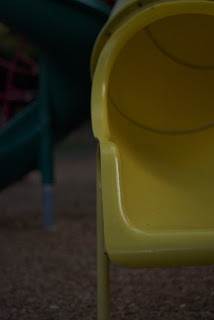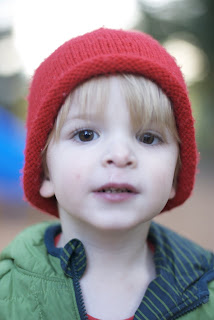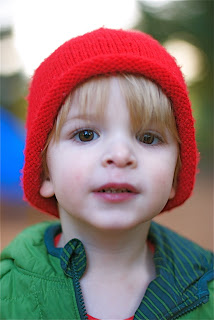 Shutter 1/400 Aperture f/1.6 ISO 400
Shutter 1/400 Aperture f/1.6 ISO 400When I initially got to the park with Henry, the ISO was set at 1600 and it was still pretty light out so I figured I could drop it to 400 and work with the shutter and/or aperture to bring in more light. It helps me to remember that shutter is really a time tool - how long the sensor in the camera is exposed to light. If you only adjust the aperture on a series of pics you'll see that if the shutter is open too long, the picture will be too bright, and if the shutter isn't open long enough, the picture will be too dark. A helpful hint (to myself so I don't forget) a fast shutter speed can freeze motion (e.g., think Henry) and a slow shutter speed can capture movement (e.g., think flowing water that looks smooth*). I have had discussions about this before but apparently much math is involved because a 50mm lens on most DSLRs has a crop value of 1.5/1.6, meaning the 50mm lens is more accurately a 75-80mm lens. For this lens you need a shutter speed of at least 1/80th of a second to get a sharp image, which is what I had found to be my sweet spot today while shooting Henry.
Aperture is about how open the lens is. It can be very narrow, in which case the light is restricted, or it can be very wide, in which case lots of light streams in. The smaller the aperture number, the larger the opening. A larger aperture (meaning a lower f/#) will have your subject in focus and everything in front of and behind it blurry. A smaller aperture (meaning a higher f/#) will have everything in focus.
I caught this photo of Henry...
 I quickly dinked around with iPhoto's editing tools and learned that by adjusting the shadows I can see Henry's eye color. See...
I quickly dinked around with iPhoto's editing tools and learned that by adjusting the shadows I can see Henry's eye color. See...
 This has the potential to be very awesome, although for now it remains just one more thing I need to learn how to do.
This has the potential to be very awesome, although for now it remains just one more thing I need to learn how to do.
*I read somewhere that you can achieve this effect using a tripod and setting your shutter speed to slower than 1/8th of a second.
Aperture is about how open the lens is. It can be very narrow, in which case the light is restricted, or it can be very wide, in which case lots of light streams in. The smaller the aperture number, the larger the opening. A larger aperture (meaning a lower f/#) will have your subject in focus and everything in front of and behind it blurry. A smaller aperture (meaning a higher f/#) will have everything in focus.
I caught this photo of Henry...
 I quickly dinked around with iPhoto's editing tools and learned that by adjusting the shadows I can see Henry's eye color. See...
I quickly dinked around with iPhoto's editing tools and learned that by adjusting the shadows I can see Henry's eye color. See... This has the potential to be very awesome, although for now it remains just one more thing I need to learn how to do.
This has the potential to be very awesome, although for now it remains just one more thing I need to learn how to do.*I read somewhere that you can achieve this effect using a tripod and setting your shutter speed to slower than 1/8th of a second.





3 comments:
What I want to know is if folks are looking at you funny when you're taking 500 pictures of an empty slide!
And what I also want to know (because I can never just say one thing and leave it at that) is if it's unreasonable to expect that I could get pictures like the second one of Henry without doing any editing. Is it just a given that every good picture is edited? If so, I'm not happy about that... but it could help to lower my standards I suppose.
Not too many at the park these days. I think it's because it gets dark so quickly.
In class it sort of sounded like much of the work is done in post-production so, um, I'm assuming the truly great edit-free pic is hard to come by. You create your fantastic pics after you've taken them.
very cool. looks like you are doing what I didn't do enough of after my classes: practicing!
I use picasa because we don't have macs. it's fine for snapshots, but it would be cool to learn how to use photoshop!
Post a Comment